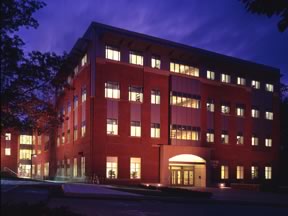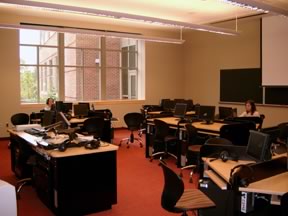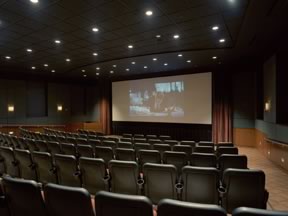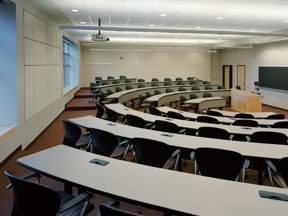Chapter 24. Messiah College: Boyer Hall
What Is It?
The new Boyer Hall at Messiah College was designed by Ayers/Saint/Gross. The largest academic building on the campus, it houses roughly 50 percent of the academic departments and 40 percent of the faculty. (See Figure 1.) As such, the building is central to the academic life on campus. Beyond the essential academic functions of hosting classes and providing open and inviting faculty offices, the building also hosts a variety of events that reach out to the larger community. Some of these include banquets and receptions in the atrium or on the exterior terrace and film festivals in the Parmer Cinema. The building is also used extensively in the summer as an integral part of an active schedule of conferences for outside organizations hosted by the college.
Figure 1. Boyer Hall

Messiah College is a Christian college of the liberal and applied arts and sciences whose mission is to educate men and women toward maturity of intellect, character, and Christian faith in preparation for lives of service, leadership, and reconciliation in church and society. Messiah College offers a private, coed, undergraduate education for more than 2,900 students in a residential setting. The main campus is located on 485 acres in Grantham, Pennsylvania, approximately 12 miles southwest of Harrisburg. The college also has a satellite campus in Philadelphia that is affiliated with Temple University.
What Happens Here?
Boyer Hall provides instruction, research, and outreach in formal and informal settings.
Instruction, Research, Collaboration
Boyer Hall is an academic building designed to house the 11 departments of the School of Humanities and the School of Education and Social Sciences. Its 18 general classrooms range in size from 30 to 60 seats, and a dedicated education classroom is furnished with shelving, cabinets, and a countertop and sink for the hands-on projects that are integral to the education curriculum. The building also has a tiered 70-seat classroom with built-in tables providing power and data connectivity for students, two computer labs, and one language lab furnished with computers at each student station. The language lab is arranged in hexagonal clusters of six seats each to promote interaction among students. (See Figure 2.)
Figure 2. Language Lab

The Boyer Center suite, adjacent to the main lobby, houses the archives of the building's namesake, Messiah College alumnus Ernest L. Boyer, Sr., a prominent educator who served as secretary of education under President Carter. The suite also includes offices for visiting faculty. Four interview rooms and a group play area flanked by two observation rooms support the psychology department's research into childhood development.
Group projects and interdisciplinary learning are supported by resource rooms located at the ends of the main corridor. Embedded within the faculty office suites, these light-filled spaces encourage mentoring and interaction between faculty and students.
Special Events
Banquets and receptions are held in the atrium or on the exterior terrace. Film festivals take place in the Parmer Cinema. This 129-seat cinema/auditorium on the ground floor supports the film studies program and doubles as an auditorium for larger lecture classes. (See Figure 3.) The double-height atrium (see Figure 4) and adjacent exterior terrace are the "living room" of this facility. Filled with natural light and views of the adjacent grove of trees, this space provides opportunities for quiet study or student-faculty interaction. The building is also used extensively in the summer as an integral part of an active schedule of conferences for outside organizations hosted by the college.
Figure 3. Parmer Cinema

Figure 4. Atrium

How Is Technology Used?
Boyer Hall provides technology support in the general classrooms, Parmer Cinema, language lab, and interview/observation rooms (http://soundandcommunications.com/applications/2005_05_apps.htm). The building is equipped with a generous number of data outlets both in the classrooms and in corridors near built-in bench alcoves. (See Figure 5.)
Figure 5. Corridor Nook

Each classroom is equipped with an instructor's station housing a PC, DVD player, VCR, and document camera. A Crestron control unit integrates these devices with a ceiling-mounted LCD projector and retractable projection screen. The larger classrooms also allow lighting and motorized shades to be controlled from the instructor's station. (See Figure 6.)
Figure 6. Classroom

A working cinema with two film projectors supporting 16 and 32mm media, the Parmer Cinema facility also includes the same digital technology provided in the general classrooms. For maximum flexibility, the A/V, lighting, and window shades can be controlled from the projection room or the instructor's station at the front of the room.
The language lab uses a low-profile raised floor system to distribute power and data cabling to furniture clusters (http://www.zephyrcomm.com/nexus.htm). Language instruction is facilitated by a special software system installed on the PCs in the space. The room is also equipped with the same A/V and controls as the general classrooms.
Interview rooms are equipped with inconspicuous, ceiling-mounted cameras and microphones connected to two observation rooms.
What Makes the Space Successful?
Several factors contribute to Boyer Hall's success: integrated technology, a variety of classroom sizes and shapes, and the provision of informal gathering spaces.
The integration of the A/V technology with lighting and window shades allows total control of the environment from the instructor's station in each classroom. Ample chalkboard space is available even when the projection screen is in use. The variety and quantity of classrooms bring a dynamic level of activity to the building and encourage interdisciplinary learning. Because the building hosts such a large percentage of classes and faculty on the campus, students and faculty from diverse backgrounds have the opportunity to interact and build the collegial atmosphere so important to Messiah College.
The resource rooms, atrium, and generous corridors with built-in benches and display cases all encourage interaction among students and faculty. Interaction among departments is facilitated as well due to their colocation in Boyer Hall.
What Principles Were Behind the Design?
A collaborative design effort between the master plan and building design resulted in a building well suited to its site and context. The design team met extensively with the building users to ensure that the design would meet the unique needs of Messiah College. Because of the size and complexity of the program, listening to and guiding the various user groups through the design process was essential to the project's success.
Another guiding principle in the design of the building was to encourage openness and communication between faculty and students, among departments, and between interior and exterior spaces. The faculty offices were located in close proximity to the classrooms and designed to be open to the public corridor with no intermediate space separating faculty from students. The principle of openness was also a driving force in the development of the atrium as a two-story space at the heart of the building with a large glass wall linking the atrium to the exterior terrace and grove of trees beyond.
What Is Unique or Noteworthy?
The culture of Messiah College is one of openness, teamwork, and intellectual curiosity. These qualities guided many aspects of the design with the goal of fostering open communication and learning between faculty and students, among academic departments, and between Messiah College and the larger community.
Given the size and location of Boyer Hall on campus, Messiah College gave the design team the opportunity to set a new standard of quality and architectural character to guide the future development of the heart of campus. The design team and the decision makers at the college were committed to quality and value on the project from start to finish, integrating technology and furnishings within the building. This integration was critical to the project's success, as was the freedom granted the design team. Boyer Hall blends traditional masonry construction with contemporary aluminum and glass elements that tie the building to the history of the campus while looking ahead to its future.
About the Author
Dennis Lynch is an associate with Ayers/Saint/Gross, Architects + Planners.